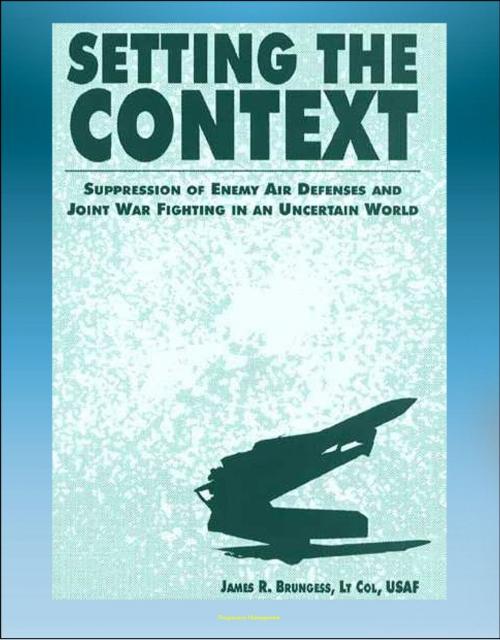Setting the Context: Suppression of Enemy Air Defenses and Joint War Fighting in an Uncertain World - including Desert Storm
Nonfiction, History, Middle East, Persian Gulf War, Military, Aviation| Author: | Progressive Management | ISBN: | 9781476071114 |
| Publisher: | Progressive Management | Publication: | June 27, 2012 |
| Imprint: | Smashwords Edition | Language: | English |
| Author: | Progressive Management |
| ISBN: | 9781476071114 |
| Publisher: | Progressive Management |
| Publication: | June 27, 2012 |
| Imprint: | Smashwords Edition |
| Language: | English |
Colonel Brungess proposes using joint suppression of enemy air defenses (JSEAD) to address the problem of reduced SEAD resources available to individual services. He contends that the demise of the Soviet Union presents the perfect transitional period for SEAD planners to create new approaches to countering the information-based integrated air defense system nets. He looks at the foundations and evolution of SEAD, identifies pertinent variables, and shows how they have changed. Colonel Brungess concludes that fiscal reality demands that the services forge joint SEAD tactics and doctrine.
Contents * FOREWORD * PREFACE * INTRODUCTION * Chapter 1 * HISTORY AND DOCTRINE * The Evolutionary Construct * Vietnam * Bekaa Valley * Libya * Persian Gulf * The Larger Context * Notes * Chapter 2 * CRITERIA FOR ASSESSING SEAD EFFECTIVENESS * Methods of Analysis * The Historical Approach * The Engineering Approach * The Commonsense Approach * The Objective-based Approach * Setting the Context: Continuums as Assessment Tools * Challenges for Objective-based Criteria * Notes * Chapter 3 * SERVICE APPROACHES TO SEAD * Navy SEAD * Air Force SEAD * Army SEAD * Marine SEAD * Notes * Chapter 4 * THE MERITS OF JSEAD: THE QUEST TO ACHIEVE EFFECTIVENESS * The Personality of JSEAD and the Threat * The World of "Joint" and JSEAD * Brave New World: 'True" Joint SEAD * The Four Continuums: How to Use Them * The Need: Resource-based Continuum * The Threat: Capability-based Continuum * The Piecemeal/Integrated Tactics Continuum * The Defensive/Offensive Continuum * The General Context: A New Way of Looking at JSEAD * Notes * Chapter 5 * JSEAD: STRATEGY, TACTICS, AND THE CHANGED THREAT * The Essence of the Threat * Requirements of the Information-based IADS * Detecting * Locating and Identifying * Tracking * Weapons Allocation and Employment * Defeating the IADS: Information Denial * Detection as Information * Locating and Identifying as Information * Information Denial in the "Endgame" * Adjusting to Fiscal Reality * SEAD Tactics: Variations, Combinations, and Innovations * Variations: The "IADS Sweep" * Combining Old Tactics: SEAD and the Modern Long-Range SAM * Innovations: Information Denial via Computer Warfare * Joint SEAD Strategy: Dividing the Turf * JSEAD Tactics: So What? * Notes * Chapter 6 * WHERE TO NEXT: CONCLUSIONS AND RECOMMENDATIONS * Conclusions * SEAD as an Evolutionary Concept * Requirement for a Paradigm Shift * The Lead/Lag Issue: Joint Doctrine and JSEAD * Shifting the Focus of Criteria: * Overall Objectives * Recommendations * Education * Training * Equipment * Full Circle: The Strategy-Doctrine-Tactics Continuum
Colonel Brungess proposes using joint suppression of enemy air defenses (JSEAD) to address the problem of reduced SEAD resources available to individual services. He contends that the demise of the Soviet Union presents the perfect transitional period for SEAD planners to create new approaches to countering the information-based integrated air defense system nets. He looks at the foundations and evolution of SEAD, identifies pertinent variables, and shows how they have changed. Colonel Brungess concludes that fiscal reality demands that the services forge joint SEAD tactics and doctrine.
Contents * FOREWORD * PREFACE * INTRODUCTION * Chapter 1 * HISTORY AND DOCTRINE * The Evolutionary Construct * Vietnam * Bekaa Valley * Libya * Persian Gulf * The Larger Context * Notes * Chapter 2 * CRITERIA FOR ASSESSING SEAD EFFECTIVENESS * Methods of Analysis * The Historical Approach * The Engineering Approach * The Commonsense Approach * The Objective-based Approach * Setting the Context: Continuums as Assessment Tools * Challenges for Objective-based Criteria * Notes * Chapter 3 * SERVICE APPROACHES TO SEAD * Navy SEAD * Air Force SEAD * Army SEAD * Marine SEAD * Notes * Chapter 4 * THE MERITS OF JSEAD: THE QUEST TO ACHIEVE EFFECTIVENESS * The Personality of JSEAD and the Threat * The World of "Joint" and JSEAD * Brave New World: 'True" Joint SEAD * The Four Continuums: How to Use Them * The Need: Resource-based Continuum * The Threat: Capability-based Continuum * The Piecemeal/Integrated Tactics Continuum * The Defensive/Offensive Continuum * The General Context: A New Way of Looking at JSEAD * Notes * Chapter 5 * JSEAD: STRATEGY, TACTICS, AND THE CHANGED THREAT * The Essence of the Threat * Requirements of the Information-based IADS * Detecting * Locating and Identifying * Tracking * Weapons Allocation and Employment * Defeating the IADS: Information Denial * Detection as Information * Locating and Identifying as Information * Information Denial in the "Endgame" * Adjusting to Fiscal Reality * SEAD Tactics: Variations, Combinations, and Innovations * Variations: The "IADS Sweep" * Combining Old Tactics: SEAD and the Modern Long-Range SAM * Innovations: Information Denial via Computer Warfare * Joint SEAD Strategy: Dividing the Turf * JSEAD Tactics: So What? * Notes * Chapter 6 * WHERE TO NEXT: CONCLUSIONS AND RECOMMENDATIONS * Conclusions * SEAD as an Evolutionary Concept * Requirement for a Paradigm Shift * The Lead/Lag Issue: Joint Doctrine and JSEAD * Shifting the Focus of Criteria: * Overall Objectives * Recommendations * Education * Training * Equipment * Full Circle: The Strategy-Doctrine-Tactics Continuum















